And again we tested a cell phone produced by “Linus Trade”. This is the iTravel LM-810 (also called the i-Travel 2 City). It’s a little bit different from other rugged cell phones. First of all, this is a dual SIM phone. Secondly, it is proclaimed as the thinnest robust handset (19 mm or 0.7 inches). Actually, this is not true because there are thinner ruggedized mobile phones. The iTravel LM810 is IP57 certified (dust and water). So it can survive deep immersions in water.
In the package box we found a hand powered charger (Pic. 1, 2). The phone has a refined design. It is comfortable to use and feels solid in the hand (Pic. 3 – 5). The specifications are not rich. There is a camera, flashlight, Bluetooth and FM radio.
As usual, we tested 2 samples of the iTravel LM810.
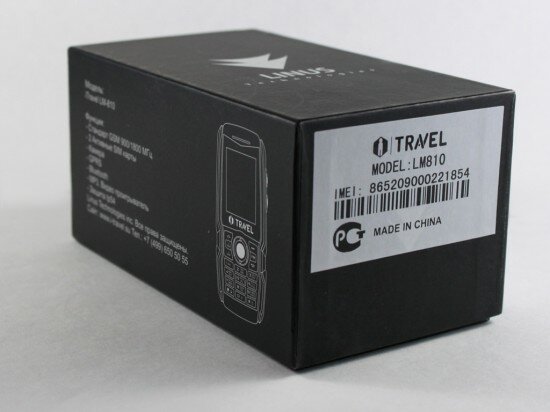
Pic. 1. The package box

Pic. 2. Accessories
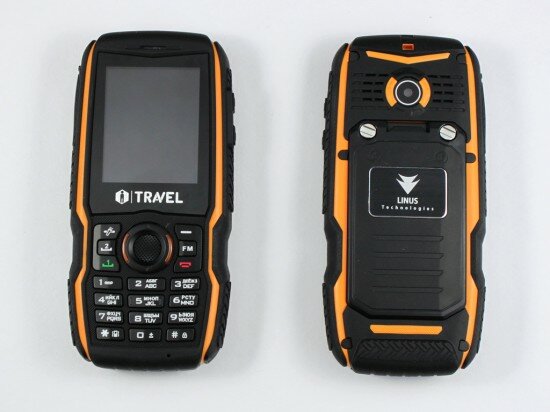
Pic. 3. The ITravel LM810 front and back side
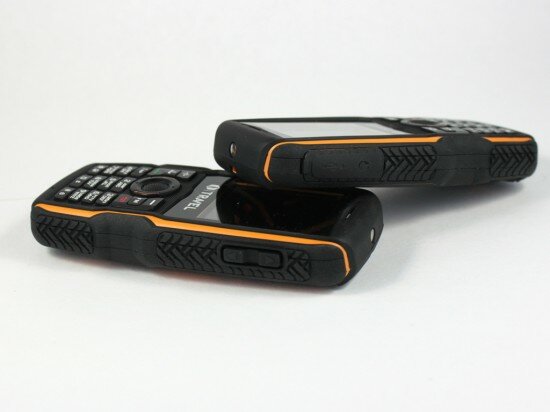
Pic. 4. The edges
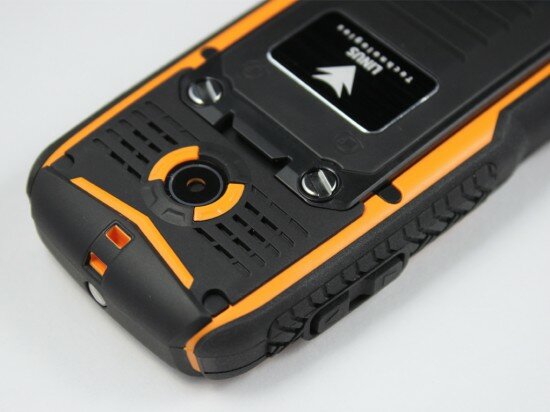
Pic. 5. A close-up view of the back cover
Stress tests of the 1st iTravel LM810 sample
1. Reception quality test
The 1st test for the iTravel LM810 concerns its reception quality. We placed the phone in a box covered in tin foil which served as an obstruction for signals from towers. We cut a slot in this box in order to give the iTravel a chance to receive calls. We experimented with different slot dimensions: 50 by 50 mm (1.97-inch by 1.97-inch), 20 by 20 mm (0.787-inch by 0.787-inch) and 15 by 15 mm (0.59-inch by 0.59-inch) (video 1 – 3).
We controlled how fine the phone received calls by watching the number of bars in the indicator that expressed signal strength. You can also see it on your mobile phone’s screen. When we started the test there was a half of the bars. But when we reduced the slot dimensions we saw only 1 bar. However, the handset received all incoming calls.
Video 1. Reception quality test (part 1)
Video 2. Reception quality test (part 2)
Video 3. Reception quality test (part 3)
Grade (part 1): 3 (with 3 being the highest possible grade)
Grade (part 2): 3 (with 3 being the highest possible grade)
Grade (part 3): 3 (with 3 being the highest possible grade)
2. Freeze test
The iTravel LM810 is considered as a dust and water resistant device. But is it freeze-proof? We checked it in this test.
Actually we placed the phone in a freezer. We kept it there in speaking mode for 2 hours and then for 30 minutes in standby mode. The temperature in the freezer was -15 °С (5 °F) at that time.
The phone worked during the whole test. The battery stayed full. There were all the bars in the battery strength indicator. The display responded immediately. The physical keyboard also worked fine but some of the buttons temporarily became a little bit stiff. The volume rocker of this handset is stiff even in moderate temperatures. We could hardly control the volume of sound with the help of it because it was frozen.
We think that this is not a serious problem because we could make and receive calls without using the volume rocker. So we decided not to lower the grade for the phone in this test.
Video 4. The phone after the freeze test
Grade: 3 (with 3 being the highest possible grade)
3. Short circuit of the battery charger
We started to check how the iTravel LM810 withstands different types of electric shocks. At first we made a short circuit of the battery charger. We closed the terminals (+ and -) of the charger for 1 second with the help of the forceps (video 5).
The battery charger sustained no damage and stayed functional.
Video 5. Short circuit of the battery charger
Grade: 3 (with 3 being the highest possible grade)
4. Short circuit of the battery
We tested the battery the same way. It also stayed fine after the short circuit (video 6).
Video 6. Short circuit of the battery
Grade: 3 (with 3 being the highest possible grade)
5. The raise in charging voltage
In this test we found out the phone’s reaction to a raise in charging voltage (video 7). We plugged the charger cable into a power supply unit and fixed charging voltage at 5 volts. Then we raised it to 8 volts.
When the charging voltage rose to 7.2 volts the phone stopped charging. The current consumption increased slightly. Ideally it should be zero. So we can infirm that there are some problems with protection system from high charging voltage.
Video 7. The raise in charging voltage
Grade: 3 (with 3 being the highest possible grade)
6. Overvoltage
In order to check the iTravel’s ability to withstand overvoltage we plugged the power supply unit into the phone instead of the battery and raised the rate of energy to 7 volts (video 8).
At first the phone malfunctioned and then rebooted by itself. It came back to initial settings and continued to work. By the way, all information was lost (missed and received calls, phonebook entries etc.)
Video 8. Overvoltage
Grade: 2 (with 3 being the highest possible grade)
7. Leaving the phone out in the rain
We checked the iTravel LM810’s water splash resistance by putting it under shower for 60 seconds (video 9).
As we expected, rain is not a problem for such a ruggedized cell phone. The innards, the battery and the USB port were absolutely dry after this test.
Video 9. Leaving the phone out in the rain
Grade: 3 (with 3 being the highest possible grade)
8. Immersion in water at a shallow depth
This time we dunked the phone under water for 20 seconds (video 10).
The sound from the loudspeaker became lower than it had been before. We solved this problem by shaking drops of water out the phone. The sound quality was restored.
Video 10. Immersion in water at a shallow depth
Grade: 3 (with 3 being the highest possible grade)
9. Immersion in water at one meter (3.28 feet) for 20 seconds
Only unprotected cell phones are eligible for this test.
Grade: –
10. Immersion in water at a one meter depth for 30 minutes
Only IPx1-IPx6 waterproof cell phones are eligible for this test.
Grade: –
11. Immersion in water at a two meter depth
They claim that the iTravel LM810 can survive immersion in water at a 1 meter depth. But we dunked it at a 2 meter depth and checked how it could cope with it. The phone lay on the bottom of a long pipe for an hour (video 11, 12).
Let’s come back to the test of the iTravel LM121b for a moment. This phone has the same of protection and it successfully passed this test. But the LM810 showed poor results. Water penetrated into the handset and the display stopped working (video 13). At the end of the experiment the space between the display and the screen glass was filled by water (video 14). We also saw a few drops of water in the battery compartment. The USB port also got wet. However, the phone worked despite the ruined picture on the screen.
We should say that IPx7 protection allows to dunk a cell phone under water at a 1 m depth. And it’s normal if water penetrates into the phone. But it shouldn’t influence the work of the device.
We dried the iTravel LM810 for a long time. We put the phone in a warm place and it lay there for 2 days. We also shook it from time to time. At last, we understood why water penetrated under the screen glass. You see, the glass was inappropriately stuck to the phone. There was a small gap though which water penetrated inside. Drops of water fell out of this gap when we shook the phone.
Video 11. The pipe
Video 12. Immersion in water at a two meter depth
Video 13. After 5 minutes of immersion
Video 14. The state of the phone after the test
Grade: 2 (with 3 being the highest possible grade)
12. Immersion in beer
In this test we dunked the phone under beer. We didn’t use the pipe for it. We submerged the iTravel only at a 4 cm depth (1.5 inches). The experiment lasted for 10 seconds (video 15).
Of course, the phone sustained no damage and stayed functional. We washed it with earm water and dried it out.
Video 15. Immersion in beer
Grade: 3 (with 3 being the highest possible grade)
13. Disassembling. Build quality
Inside the iTravel LM810 we saw nothing special (Pic. 6). The innards are composed the same way as that of the majority of budget cell phones. Between the front and back panel there is a rubber frame. The loudspeaker grill and the microphone are protected by rubber cushions (Pic. 7). The keyboard is also framed by rubber which protects it from water and dust.
The circuit board is nothing to boast of. It is like the boards of all budget handsets. All the elements (e.g. the camera, the microphone, the display) are soldered besides the antenna and the loudspeaker (Pic. 8, 9). Such design and the number of non-removable elements make the circuit board very difficult to repair.
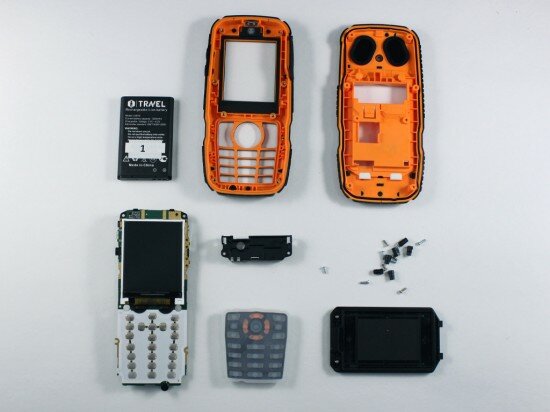
Pic. 6. The phone disassembled
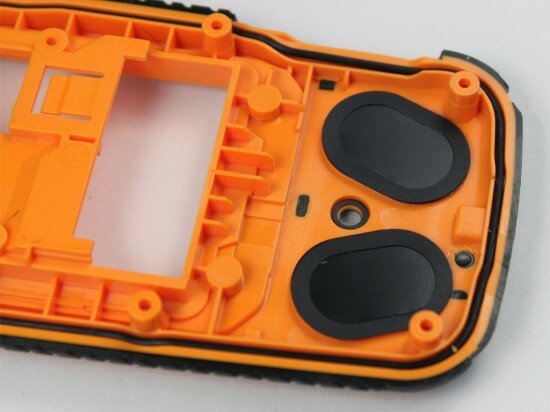
Pic. 7. The cushions of the microphone and the loudspeaker
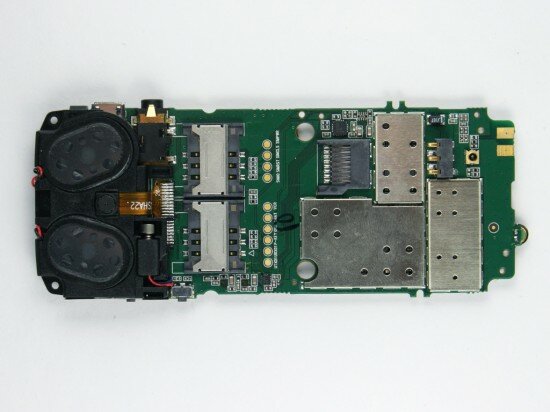
Pic. 8. The back side of the circuit board
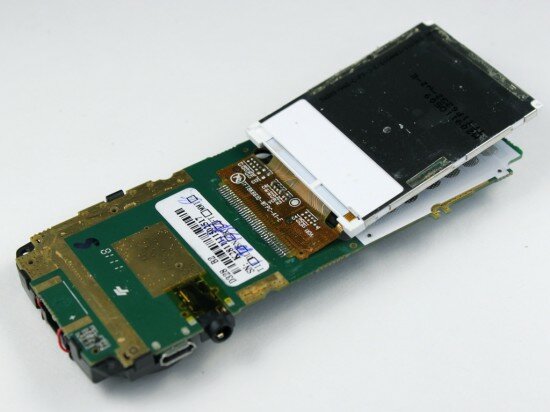
Pic. 9. The front side of the circuit board
Grade: 3 (with 3 being the highest possible grade)
14. Test of the charger cable (bend test)
In this test we bended the iTravel LM810’s headset for a lot of times. We locked the cable in a special device which bended different areas of the wire many times (video 16). The whole experiment was divided into three parts according to the amount of bends that we made (1000, 1500 and 2000 bends).
The headset sustained no damage and stayed functional though it looks cheap and simple.
Video 16. Test of the headset cable (bend test)
Grade (after 1000 bends): 3 (with 3 being the highest possible grade)
Grade (after 1500 bends): 3 (with 3 being the highest possible grade)
Grade (after 2000 bends): 3 (with 3 being the highest possible grade)
15. Test of the charger cable (tear the wire)
In the second test for the headset we tried to tear the cable by hanging loads on it (video 17). We used three different loads. Each of them weighed 1 kg (2.2 lbs). We hanged them all on the charger and fortunately it survived.
The cable showed no visible damage and the headset worked with no problem after the test.
Video 17. Test of the headset cable (tear the wire)
Grade (part 1): 3 (with 3 being the highest possible grade)
Grade (part 2): 3 (with 3 being the highest possible grade)
Grade (part 3): 3 (with 3 being the highest possible grade)
Stress tests of the second sample of the ITravel LM810
1. Reception quality test
In this chapter we are going to tell you about the stress tests of the second sample of the ITravel LM810. But the first experiment won’t cause any harm to the phone. We checked the reception quality the same way as in the previous part of our review. We used the box covered in tin foil and and the lids with different slots.
The results were also the same as in the previous reception test. At the end of the test the signal fell to one bar but the phone received all incoming calls.
Grade (part 1): 3 (with 3 being the highest possible grade)
Grade (part 2): 3 (with 3 being the highest possible grade)
Grade (part 3): 3 (with 3 being the highest possible grade)
2. Talk time
How much can a cell phone work without charging? This is a vital question especially for ruggedized handsets because travellers often take them when they go hiking.
In this test we checked the ITravel LM810’s talk time. We charged the battery, made a call, received it and left the ITravel in peace. In an hour the we were disconnected by our mobile operator. And we had to call again. So we repeated our calls every hour until the phone’s battery got empty. The phone worked for 15 hours and 30 minutes which is quite long. But the manufacturer of the ITravel claims that the talk time of their cell phone is only 3 hours.
We should say that the reception conditions were perfect during this test. In real life situations (if you are in hilly terrain far from a big city, for example) the signal may be poor and the battery will deplete faster.
Grade: 3 (with 3 being the highest possible grade)
3. Drops on the carpet
There is a very small possibility to damage a rigid and rubberized cell phone by dropping it on the carpet, isn’t it? However, we decided to perform this test and see what would happen.
So we dropped the iTravel on the carpet with each face, edge and corner from 100 cm (3.28 ft), 150 cm (4.9 ft) and 200 cm (6.56 ft) (video 18 – 20). The phone showed no visible damage and stayed functional.
Video 18. Drops on the carpet from 100 cm (3.28 ft)
Video 19. Drops on the carpet from 150 cm (4.9 ft)
Video 20. Drops on the carpet from 200 cm (6.56 ft)
Grade (100 cm): 3 (with 3 being the highest possible grade)
Grade (150 cm): 3 (with 3 being the highest possible grade)
Grade (200 cm): 3 (with 3 being the highest possible grade)
4. Drops on a tile
Drops on a tile should inflict at least some harm to the phone. The heights were smaller than in the previous test: 30 cm (11.8 inches), 50 cm (1.64 ft) and 100 cm (3.28 ft) (video 21 – 23). All in all. the phone fell for 6 times from each height.
The iTravel LM810 sustained no harm after the drops from 30 cm. But it started to malfunction when we dropped it from 50 cm. The power button didn’t respond and we had to lift the battery in order to reboot the phone. We didn’t lower the grade for it because the handset showed no damage.
During the drops from 100 cm the rubberized phone rebounded like a ball and we couldn’t even shoot it. Sometimes the cap of the USB port was opened. But the phone didn’t even malfunction and stayed functional.
Video 21. Drops on the tile from 30 cm (11.8 inches)
Video 22. Drops on the tile from 50 cm (1.64 ft)
Video 23. Drops on the tile from 100 cm (3.28 ft)
Grade (stage 1): 3 (with 3 being the highest possible grade)
Grade (stage 2): 3 (with 3 being the highest possible grade)
Grade (stage 3): 3 (with 3 being the highest possible grade)
5. Squeeze test
We placed a wooden bar on the phone and applied pressure from this bar above the casing. At first we applied 5 kg (11 lbs), then 20 kg (44 lbs) and finally we applied 50 kg (110 lbs).
The majority of unprotected cell phones pass this test with no problem. No doubt that the iTravel LM810 showed no damage.
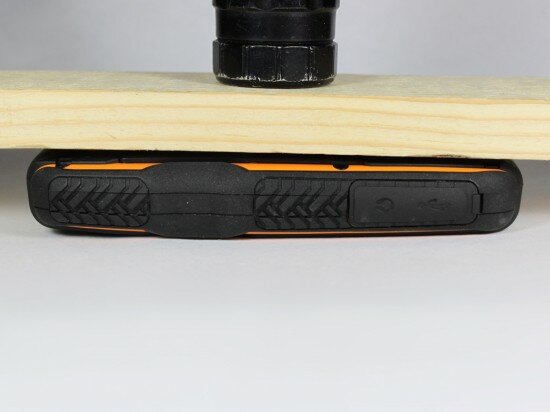
Pic. 10. Squeeze test
Grade (5 kg): 3 (with 3 being the highest possible grade)
Grade (20 kg): 3 (with 3 being the highest possible grade)
Grade (50 kg): 3 (with 3 being the highest possible grade)
6. Bend test
In this test we put the phone onto the two planks so that each edge of the phone lay on a single plank. Then we hitched a string with a load on top of the device. At first we used the load that weighed 3 kg (6.6 lbs), then we changed it for a 7 kg load (15.4 lbs) and at last we used a 15 kg load (33 lbs).
This phone is really rigid. Even under the 15 kg load there was no bend at all (Pic. 11).
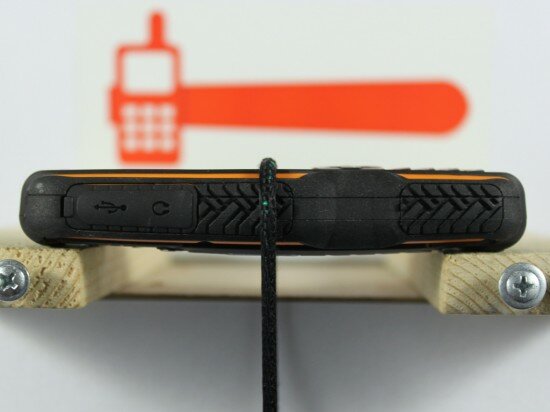
Pic. 11. The phone under a 15 kg load
Grade (3 kg): 3 (with 3 being the highest possible grade)
Grade (7 kg): 3 (with 3 being the highest possible grade)
Grade (15 kg): 3 (with 3 being the highest possible grade)
7. Keyboard
The buttons on the edges of the iTravel LM810 are quite stiff. You should bear it in mind iа you are going to buy a water and dust resistant cell phone. This is not a great disadvantage. But it it doesn’t make this phone very comfortable to use.
The keypad is a standard issue stuff. All the keys give a fine tactile respond. A person with large fingers may feel a little discomfort due to a small size of the keys, especially “FM” and “SIM2″ which are located very close to the other buttons. By the way, there are a huge gaps between the panel and the keys, especially around the navigation key. These gaps may be filled with dust in some time which can produce a bad impact on the work of the keyboard.
Grade: 2 (with 3 being the highest possible grade)
8. Dust and sand
The IP5x class of protection stands for dust resistance. It’s possible for a small grains of dust to penetrate the phone but it won’t cause any harm to the phone. So we checked how fine the iTravel LM810 can cope with dust and sand. We placed the handset in the drum filled with dirt and rotated this drum viciously for three periods of time: 1, 3 and 6 minutes (video 21). We examined the state of the phone after each part of the test.
Check out how the phone looked like after 1 minute in the drum (Pic. 12). Dust didn’t penetrate deeper than in the gaps between the keys. We heard an unpleasant noise when we pressed them.
At the second part of the test the ribs on the edges were stuffed with dust. You’ll need a brush if you want to get rid of it (Pic. 13). The grains of dust under the screen disappointed us most of all because even some of the unprotected cell phones didn’t show such an awful result (Pic. 14). We also saw some dust when we took off the back cover. But it’s not so disastrous for the phone in comparison with the dirt under the screen which will strike the eye all the time.
At the end of the test the amount of dust under the screen increased (Pic. 16). The jacks were also dirty despite the presence of the cap (Pic. 17). The only advantage of the iTravel LM810 which makes it different from simple mobile phones is its fine appearance after the test. This handset is covered in rubber which doesn’t take much scratches and scuffs (Pic. 18).
After the dust test we decided to wash the phone under it under tap. But we couldn’t get rid of the dirt that stuck between the keys and between the ribs on the edges. So it’s impossible to do it without a brush.
Video 24. Dust test
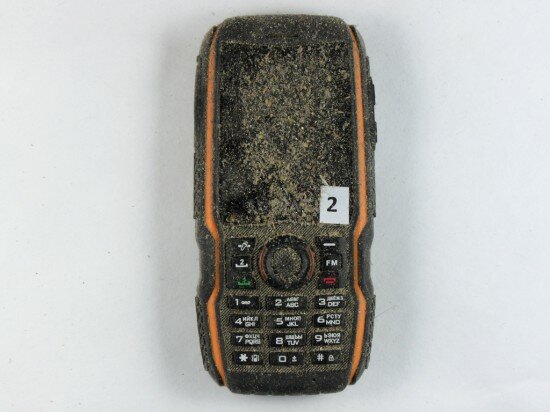
Pic. 12. Here
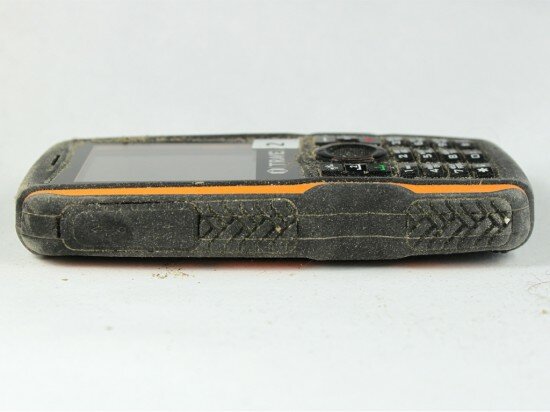
Pic. 13. Dirt between the ribs on the edges (in the middle part of the test)
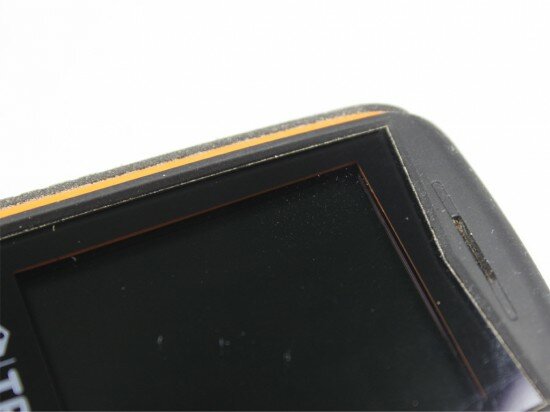
Pic. 14. Dust under the screen glass (in the middle part of the test)
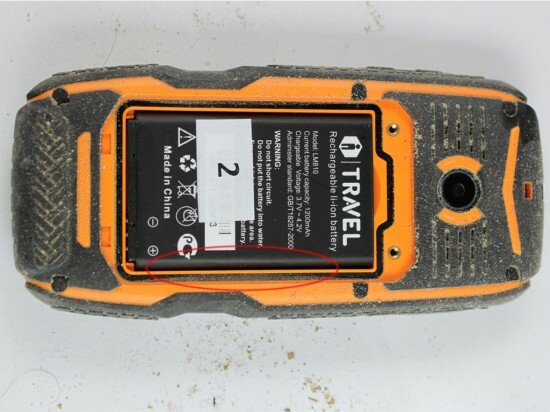
Pic. 15. Dust and sand in the battery compartment (in the middle part of the test)
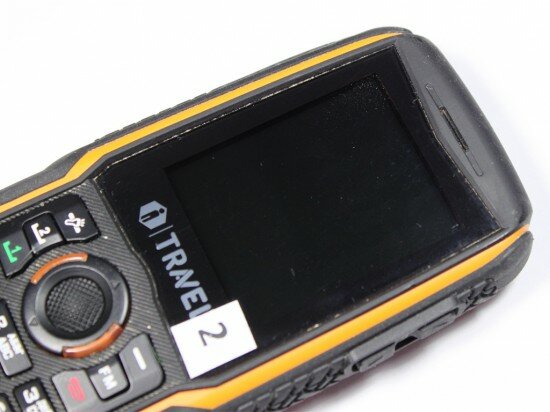
Pic. 16. Dust under the screen glass (at the end of the test)

Pic. 17. Dust in the jacks (at the end of the test)

Pic. 18. Scuffs on the rubberized edges of the phone (at the end of the test)
Grade (1 minute): 3 (with 3 being the highest possible grade)
Grade (3 minutes): 2 (with 3 being the highest possible grade)
Grade (6 minutes): 2 (with 3 being the highest possible grade)
9. Durability test
In this test we checked the iTravel LM810’s durability. Actually we simulated what might happen to the handset in a man’s pants pocket or when you rub it against a rough surface. We placed the phone with its face down in a pallet filled with small plastic balls and vibrated the pallet slightly so that the balls scuffed the screen (video 25). We also spilt a little dust and sand in the pallet to cause more harm to the phone. This experiment was divided into three parts according to the periods of time (1, 2 and 5 hours).
During the first two parts of the test the phone sustained no damage. At the end of the experiment we wiped all the dust of the handset. The deeply set screen is framed by a rubber cushion which was scuffed in some places (Pic. 19). It was visible only when we looked carefully. The navigation key also sustained harm (Pic. 20). But only attentive people can notice such damage.
Video 25. Durability test
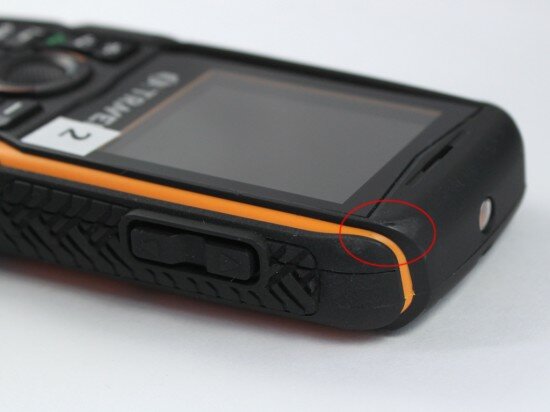
Pic. 19. Scuffs on the rubber frame
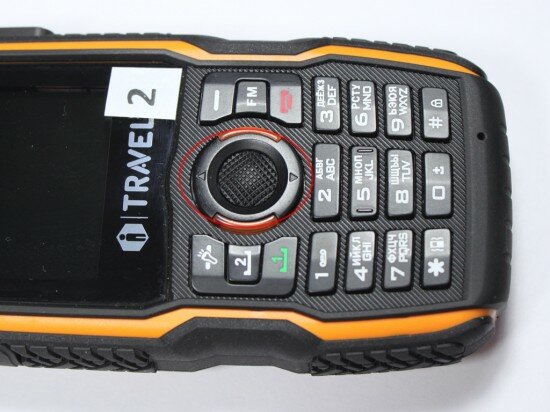
Pic. 20. This is how the navigation key was damaged
Grade (1 hours): 3 (with 3 being the highest possible grade)
Grade (2 hours): 3 (with 3 being the highest possible grade)
Grade (5 hours): 3 (with 3 being the highest possible grade)
10. Scratch test (the screen)
We checked the screen’s scratch resistance with the help of a nail. Actually we scratched it for 3 times with different force: 100 g (0.22 lbs), 300 g (0.66 lbs) and finally 600 g (1.3 lbs) (video 26).
The iTravel LM810’s screen glass is much more rigid than that of the simple phones. When we applied a 300 g force the scratch was almost invisible. But the last scratch was clear though it wasn’t very deep. In general, the iTravel showed better results in comparison with simple cell phones.
Video 26. Scratch test
Grade (the 1st attempt): 3 (with 3 being the highest possible grade)
Grade (the 2nd attempt): 3 (with 3 being the highest possible grade)
Grade (the 3rd attempt): 3 (with 3 being the highest possible grade)
11. Scratch test (back panel)
We scratched the back cover with the same force: 100 g (0.22 lbs), 300 g (0.66 lbs) and finally 600 g (1.3 lbs) (video 27).
Usually all soft touch surfaces easily take scratches. But we had a rubberized mobile phone which didn’t show any scratch after this test at all (Pic. 22).
Video 24. Scratch test (back panel)

Pic. 22. Here
Grade (the 1st attempt): 3 (with 3 being the highest possible grade)
Grade (the 2nd attempt): 3 (with 3 being the highest possible grade)
Grade (the 3rd attempt): 3 (with 3 being the highest possible grade)
12. Screen cracking
We checked the screen’s rigidity by dropping a small steel ball from different heights on it: 10, 20 and 30 cm (3.9, 5.9 and 9.8 inches) (video 28). The diameter of the ball is 22 mm (0.8 inches).
The iTravel LM810 sustained no visible damage.
Video 28. Dropping the steel ball on the phone’s screen
Grade (the 1st attempt): 3 (with 3 being the highest possible grade)
Grade (the 2nd attempt): 3 (with 3 being the highest possible grade)
Grade (the 3rd attempt): 3 (with 3 being the highest possible grade)
13. Heat test
In this test we simulated influence of direct sun rays or a flame on the iTravel. We placed the handset under the two strong lamps (150 Wt each). Each of them heated the phone for 3, 5 and 10 minutes (video 29 – 31). We checked the state of the gadget after these periods of time.
A 3 minute heating didn’t cause any harm to the phone. But after the next 5 minutes the phone’s temperature rose to 100 °С (212 °F). It sustained 3 melted buttons. During the final part of the experiment (a 10 minute heating) there was a smell of a burnt plastic. We understood that something strange happened to the phone. The buttons melted more but they worked (Pic. 23). The display became dim but the picture was restored when we cooled the phone down .
By the way, the iTravel LM121 (the other representative of the same company) had the same problem. The keyboard of this handset is made of a low quality plastic material. As a result of the heat test, the navigation key melted.
Video 29. 3 minute heating
Video 30. 5 minute heating
Video 31. 10 minute heating
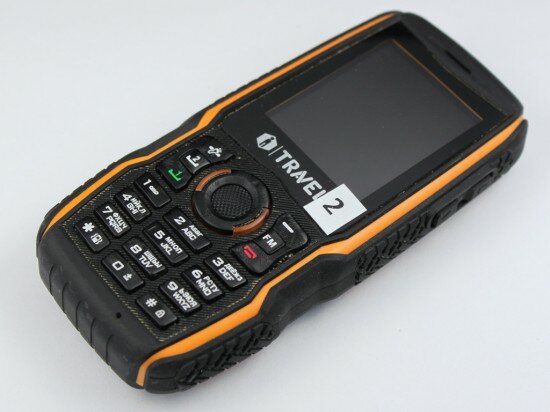
Pic. 23. The state of the phone after the heat test
Grade (3 minute heating): 3 (with 3 being the highest possible grade)
Grade (5 minute heating): 3 (with 3 being the highest possible grade)
Grade (10 minute heating): 3 (with 3 being the highest possible grade)
14. The iTravel LM810 smash
This is the last stress test for the iTravel LM810. We tried to smash this gadget against and we didn’t care about its rigidity at all. We dropped the phone on the tile from 150, 200 and 240 cm (4.9, 6.56 and 7.87 ft). We were sure that this rubberized cell phone would pass this test with no problem.
In fact, the iTravel LM810 failed this test. After the drops from 150 cm the phone looked fine but then we noticed that the microphone stopped working. All the other drops didn’t cause any harm to the phone. It sustained no visible damage. However, the iTravel turned off by itself several times after the drops. This is not appropriate for a mobile phone that claims to be called robust.
Video 32. Drops on the tile from 150 cm (4.9 ft)
Video 33. Drops on the tile from 200 cm (6.56 ft)
Video 34. Drops on the tile from 240 cm (7.87 ft)
Grade (150 cm): 1 (with 3 being the highest possible grade)
Grade (200 cm): 3 (with 3 being the highest possible grade)
Grade (240 cm): 3 (with 3 being the highest possible grade)
15. Disassembling. Build quality
We disassembled the 2nd sample of the iTravel LM810. We should say that it is a dust resistant mobile phone because there was no dust inside it (Pic. 24). However, there was a lot of dirt under the keyboard (Pic. 25). Dust was stuck to the buttons so strong that it wasn’t even shaken out during the drops. But sometimes not only dust that accumulated inside them is shaken out but also the elements that are non-removable…
The reson of the microphone damage is easy (Pic. 26). The microphone is soldered to the circuit board through a slot in the body of the phone. When we dropped the iTravel the circuit board was shifted and the microphone was locked in the borders of the slot. So it was split off the board.
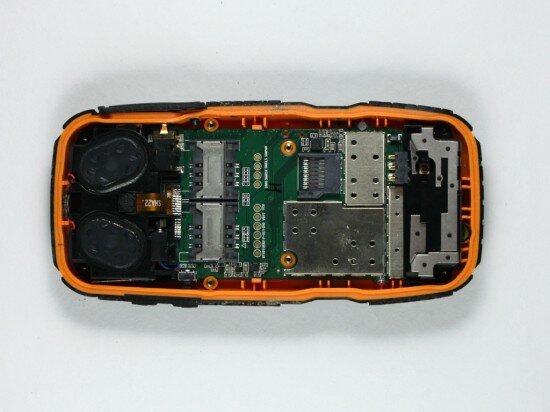
Pic. 24. The phone with an open back cover
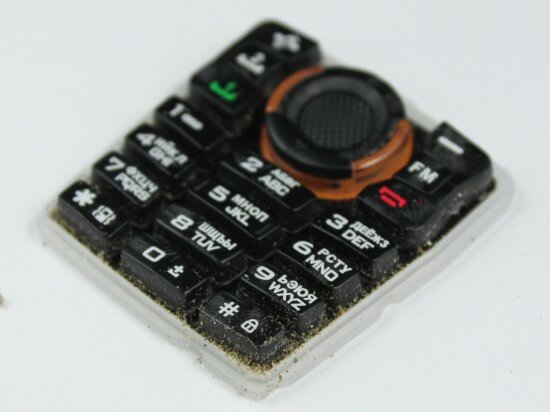
Pic. 25. The dirty keyboard
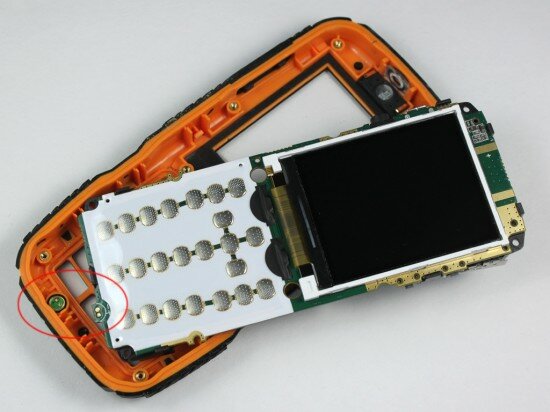
Pic. 26. The broken microphone
Grade (150 cm): 2 (with 3 being the highest possible grade)
All in all the iTravel LM810 gains 618 points (with 686 being the highest possible grade)
Final words
The iTravel LM810 showed average results in our stress tests which is fine for a simple phone but absolutely inappropriate for a rugged one.
The disadvantages are evident. The most terrible thing is the screen glass that’s badly stuck to the phone. We think that this is not only one incident. It’s a production problem of this phone. The iTravel LM121b also had a very bad screen glass through which water penetrated into the phone. But the screen of the iTravel LM810 let a lot of dust inside the handset. Both phones have defects in the same corner of the screen. The keyboard is made of a very low quality plastic material. We saw the same in the iTravel LM121b stress tests. It melted in the heat test. Though they say that this handset is dust proof we would recommend to use it with care and never throw it in dirt. Otherwise you’ll have to clean all the gaps between the buttons and multiple ribs on the edges of the phone. As for the drops on a floor or a tile. You’d better not repeat what we did.
But there are some advantages of this phone in comparison with the others that we had tested before. First of all, it works fine in cold weather. The battery stayed full. The display performed fine. The keyboard was comfortable despite frosty environment. Secondly, this phone is scratch proof. It’s really difficult to inflict a scratch on it. So you may carry this handset in a pocket with other things and not be afraid of scratches and scuffs.
You may check out the state of both cell phones on video 35 and pictures 27 – 30.
Video 35. Both samples of the iTravel LM810
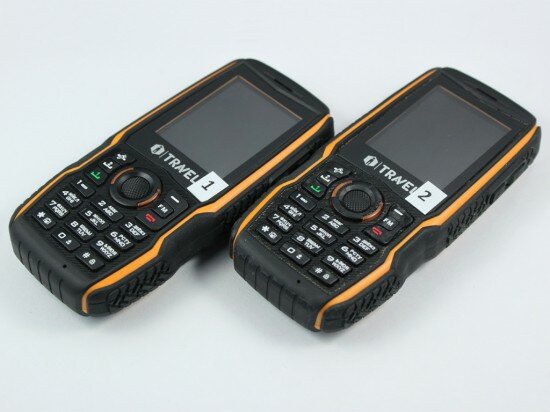
Pic. 27. Front side
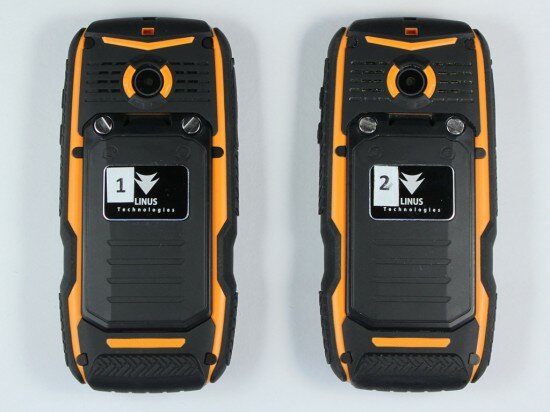
Pic. 28. Back side
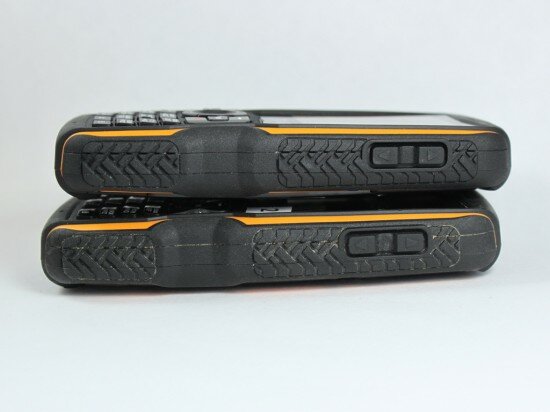
Pic. 29. View from an angle

Pic. 30. The edges

 Russian version
Russian version